What is in this leaflet
This leaflet answers some common questions about Spiriva Respimat.
It does not contain all the available information.
It does not take the place of talking to your doctor or pharmacist.
All medicines have risks and benefits. Your doctor has weighed the risks of you using Spiriva Respimat against the benefits they expect it will have for you.
If you have any concerns about using this medicine, ask your doctor or pharmacist.
This leaflet was last updated on the date at the end of this leaflet. More recent information may be available. The latest Consumer Medicine Information is available from your pharmacist, doctor or from www.medicines.org.au and may contain important information about the medicine and its use of which you should be aware.
Keep this leaflet with the medicine. You may need to read it again.
What Spiriva Respimat is used for
Spiriva Respimat is used to make breathing easier for patients with:
- chronic obstructive pulmonary disease (COPD)
- asthma.
When used to treat asthma you should use Spiriva Respimat in addition to other medicines called inhaled corticosteroids.
COPD is a serious lung condition that can cause difficulty in breathing and constant coughing. The term COPD is associated with the conditions chronic bronchitis and emphysema. Spiriva Respimat helps to improve your COPD condition and to prevent exacerbations (periodic worsening of symptoms) from occurring.
Asthma is a serious lung condition where the lining of the lungs becomes inflamed (red and swollen), making it difficult to breathe. This may be due to an allergy to house dust mites, smoke or other irritants.
Spiriva Respimat improves breathing by relaxing the breathing tubes or air passages that carry air to and from the lungs.
Spiriva Respimat contains the active ingredient tiotropium bromide monohydrate. It belongs to a group of medicines called anticholinergics.
Ask your doctor if you have any questions about why this medicine has been prescribed for you. Your doctor may have prescribed it for another reason.
Before you use Spiriva Respimat
When you must not use it
Do not use Spiriva Respimat if you have an allergy to:
- any medicine containing tiotropium bromide
- any of the ingredients listed at the end of this leaflet
- any medicine containing atropine or its derivatives, e.g. ipratropium or oxitropium
- any other anticholinergic medicines.
Symptoms of an allergic reaction may include:
- shortness of breath
- wheezing or difficulty breathing
- swelling of the face, lips, tongue or other parts of the body
- rash, itching or hives on the skin
Do not use Spiriva Respimat to treat an acute asthma attack or sudden attack of breathlessness, wheezing or coughing. You will need a different type of medicine for this.
Do not give Spiriva Respimat to children below the age of 6 years.
Do not use this medicine after the expiry date printed on the inhaler label or carton, or if the packaging is torn or shows signs of tampering. If it has expired or is damaged, return it to your pharmacist for disposal.
If you are not sure whether you should start using this medicine, talk to your doctor.
Before you start to use it
Tell your doctor or pharmacist if you have allergies to any other medicines, foods, preservatives or dyes.
Tell your doctor if you have, or have had, any of the following medical conditions:
- high pressure in the eye (glaucoma)
- kidney or liver problems
- problems with your prostate gland
- problems with passing urine
- you have suffered from a heart attack during the last 6 months or from any unstable or life threatening irregular heart beat or severe heart failure within the past year
Tell your doctor if you are pregnant or plan to become pregnant or are breast-feeding. Your doctor can discuss with you the risks and benefits involved. Spiriva is not generally recommended for use in pregnant women.
Do not allow the mist to enter your eyes. Should this occur, immediately flush your eyes with cold tap water for several minutes and immediately consult your doctor for further advice. If the mist enters the eye, it may result in eye pain or discomfort, blurred vision, seeing halos around lights or coloured images in association with red eyes (i.e. narrow angle glaucoma). Eye symptoms may be accompanied by headache, nausea or vomiting.
Use this medicine only with the Respimat device.
Taking other medicines
Tell your doctor or pharmacist if you are taking any other medicines, including any that you buy without a prescription from your pharmacy, supermarket or health food shop.
Some medicines and Spiriva Respimat may interfere with each other. These include other anticholinergic medicines such as glycopyrronium, aclidinium, umeclidinium, or ipratropium.
These medicines may be affected by Spiriva Respimat or may affect how well it works. You may need different amounts of your medicines, or you may need to take different medicines.
Your doctor or pharmacist has more information on medicines to be careful with or avoid while using this medicine.
How to use Spiriva Respimat
Follow all directions given to you by your doctor or pharmacist carefully. They may differ from the information contained in this leaflet.
If you have been prescribed Spiriva Respimat for your asthma it should be added on to your treatments that include an inhaled corticosteroid.
If you do not understand the instructions on the box, ask your doctor or pharmacist for help.
How much to use
Take TWO PUFFS, once a day at the same time of the day. You need to take two puffs to get the full dose.
Do not take more than the recommended dose.
How to use it
Spiriva Respimat is for inhalation use only.
Make sure that you know how to use your Spiriva Respimat inhaler properly. The instructions for use are provided at the end of this leaflet.
Carefully read the instructions for use and follow the diagrams that show you how to use the Spiriva Respimat inhaler.
If you do not understand the instructions on how to use the Spiriva Respimat inhaler, ask your doctor or pharmacist for help.
Use the Spiriva Respimat inhaler supplied in the pack to breathe in the solution containing the medicine from the Spiriva Respimat cartridge.
Insert the Spiriva Respimat cartridge into the Spiriva Respimat inhaler to prepare the inhaler for first use.
The Spiriva Respimat inhaler releases a mist of solution slowly and gently, making it easy to inhale it into your lungs where it is needed. The mist containing the medication is released by pressing the dose release button.
When to use it
Use your medicine at about the same time each day. Using it at the same time each day will have the best effect. It will also help you remember when to use it.
How long to use it
Continue to use Spiriva Respimat for as long as your doctor tells you.
Spiriva Respimat helps to control your condition but it does not cure it. Therefore you must use Spiriva Respimat every day. It is important to keep taking your medicine even if you feel well.
If you forget to use it
If you forget to use your Spiriva Respimat, use it as soon as you remember.
If it is almost time for your next dose, skip the dose you missed and inhale just one dose at your usual time the next day.
Do not take a double dose to make up for the dose that you missed. This may increase the chance of you getting an unwanted side effect.
If you are not sure what to do, ask your doctor or pharmacist.
If you have trouble remembering to take your medicine, ask your pharmacist for some hints.
If you use too much (overdose)
Immediately telephone your doctor or the Poisons Information Centre 13 11 26 for advice, or go to Emergency at your nearest hospital, if you think that you or anyone else may have used too much Spiriva Respimat. Do this even if there are no signs of discomfort or poisoning. You may need urgent medical attention.
Symptoms of an overdose may include fast or irregular heartbeat, blurred vision, nausea, stomach pain, dry mouth, constipation, difficulty passing urine.
While you are using Spiriva Respimat
Things you must do
If you are about to be started on any new medicine, remind your doctor or pharmacist that you are using Spiriva Respimat.
Tell any other doctors, dentists and pharmacists who are treating you that you are using this medicine.
If you are going to have surgery, tell the surgeon or anaesthetist that you are taking this medicine. It may affect other medicines used during surgery.
If you become pregnant while using this medicine, tell your doctor immediately.
If you are a smoker, you should stop smoking. Your doctor or pharmacist can advise you on the steps to take to quit smoking.
If you have an Asthma Action Plan that you have agreed with your doctor, follow it closely at all times.
If you have been prescribed Spiriva Respimat for your asthma it should be added on to your treatments that include an inhaled corticosteroid. Continue taking the inhaled corticosteroid as prescribed by your doctor, even if you feel better.
Keep all of your doctor's appointments so that your progress can be checked. Your doctor may do some tests from time to time to make sure the medicine is working and to prevent unwanted side effects.
Things you must not do
Do not use Spiriva Respimat to treat any other complaints unless your doctor tells you to.
Do not give this medicine to anyone else, even if they have the same condition as you.
Do not take any other medicines for your breathing problems without checking with your doctor.
Do not use Spiriva Respimat to relieve an acute attack of breathlessness or wheezing.
If you become wheezy or tight in the chest before your next dose of Spiriva Respimat is due, use a 'reliever puffer' in the usual way.
Spiriva Respimat should only be used as the maintenance treatment of your COPD or asthma.
Do not stop using your medicine or lower the dosage without checking with your doctor. If you stop using it suddenly or lower the dosage, the signs and symptoms of your COPD may worsen.
Do not take Spiriva Respimat more frequently than once daily.
Things to be careful of
Be careful when driving or operating machinery until you know how Spiriva Respimat affects you. This medicine may cause dizziness or blurred vision in some people. If you have any of these symptoms, do not drive, operate machinery or do anything else that could be dangerous.
Pay attention to oral hygiene. Dry mouth which has been observed with anticholinergic treatment may in the long term be associated with tooth decay.
Side effects
Tell your doctor or pharmacist as soon as possible if you do not feel well while you are using Spiriva Respimat.
This medicine helps most people with COPD or asthma, but it may have unwanted side effects in a few people. All medicines can have side effects. Sometimes they are serious, most of the time they are not. You may need medical attention if you get some of the side effects.
Do not be alarmed by the following lists of side effects. You may not experience any of them.
Ask your doctor or pharmacist to answer any questions you may have.
Tell your doctor or pharmacist if you notice any of the following and they worry you:
- dry mouth: this is usually mild
- sore mouth, gums, or throat; swollen, red, sore tongue
- oral thrush
- hoarse voice
- nose bleeds
- cough
- dry skin
- skin infection or skin ulcer
- dizziness
- trouble sleeping
Tell your doctor as soon as possible if you notice any of the following:
- blurred vision
- seeing halos around lights or coloured images in association with red eyes; high pressure in the eye (glaucoma)
- difficulty in swallowing
- heartburn
- difficulty or pain when passing urine, urinary tract infection, increased need and frequency in passing urine
- constipation
- worsening of breathing problems (induced by the inhalation process). Inhaled medicines such as Spiriva Respimat may cause tightness of the chest, coughing, wheezing or breathlessness immediately after inhalation
The above list includes serious side effects that may require medical attention.
If any of the following happen, tell your doctor immediately or go to Emergency at your nearest hospital:
- fast or irregular heartbeats, palpitations
- shortness of breath, wheezing or difficulty breathing; swelling of the face, lips, mouth, tongue, or throat which may cause difficulty in swallowing or breathing; swelling of other parts of the body; rash, itching or hives on the skin
The above list includes very serious side effects. You may need urgent medical attention or hospitalisation.
Tell your doctor or pharmacist if you notice anything that is making you feel unwell.
Other side effects not listed above may occur in some people.
After using Spiriva Respimat
Care and cleaning
Follow the instructions at the end of this leaflet on how to clean and take care of your Spiriva Respimat.
Clean the mouthpiece including the metal part inside the mouthpiece with a damp cloth or tissue only, at least once a week.
It is important to keep your inhaler clean and dry. It may not work as well if it gets dirty.
Storage
Keep Spiriva Respimat in a cool dry place where the temperature stays below 25°C. Do not freeze.
Do not store Spiriva Respimat or any other medicine in the bathroom or near a sink. Do not leave it on a window sill or in the car. Heat and dampness can destroy some medicines.
Keep it where children cannot reach it. A locked cupboard at least one-and-a-half metres above the ground is a good place to store medicines.
Discard Spiriva Respimat inhaler 3 months after inserting the Spiriva Respimat cartridge into the Spiriva Respimat inhaler even if it contains some unused medicine, or when the inhaler is locked (after 60 puffs), whichever comes first.
Disposal
If your doctor tells you to stop using this medicine, or the expiry date has passed, or it has been more than 3 months after its first use, or if the inhaler has locked (after 60 puffs), ask your pharmacist how to dispose of it properly.
Product Description
What it looks like
Spiriva Respimat is composed of one cartridge with solution for inhalation and one Respimat inhaler. The cartridge has to be inserted into the inhaler before first use.
Each pack consists of:
- one Respimat inhaler (with a green-coloured cap) and
- one Spiriva Respimat cartridge providing 60 puffs (equal to 30 doses of medicine).
Ingredients
Spiriva Respimat contains 2.5 micrograms tiotropium (as bromide monohydrate) per puff.
It also contains:
- benzalkonium chloride
- disodium edetate
- purified water
- hydrochloric acid for pH adjustment.
Supplier
Spiriva Respimat is supplied in Australia by:
Boehringer Ingelheim Pty Limited
ABN 52 000 452 308
Sydney, Australia
www.boehringer-ingelheim.com.au
This Consumer Medicine Information was revised in September 2020
Spiriva® and Respimat® are registered trademarks of Boehringer Ingelheim
© Boehringer Ingelheim Pty Limited 2020
Australian Registration Number:
AUST R 132578
Instructions for Use
Introduction
Read these Instructions for Use before you start using Spiriva Respimat (tiotropium bromide monohydrate).
Children should use Spiriva Respimat with an adult’s assistance.
You will need to use this inhaler only ONCE A DAY. Each time you use it take TWO PUFFS.
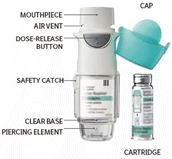
How to store my Spiriva Respimat
- Keep your Spiriva Respimat out of the sight and reach of children.
- Do not freeze your Spiriva Respimat.
- If Spiriva Respimat has not been used for more than 7 days release one puff towards the ground.
- If Spiriva Respimat has not been used for more than 21 days repeat steps 4 to 6 under ‘Prepare for first use’ until a cloud is visible. Then repeat steps 4 to 6 three more times.
- Do not use your Spiriva Respimat after the expiry date.
- Do not touch the piercing element inside the clear base.
How to care for your Spiriva Respimat
Clean the mouthpiece including the metal part inside the mouthpiece with a damp cloth or tissue only, at least once a week.
Any minor discoloration in the mouthpiece does not affect your Spiriva Respimat inhaler performance.
When to get a new Spiriva Respimat
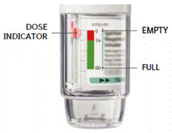
- Your Spiriva Respimat inhaler contains 60 puffs (30 doses) if used as indicated (two puffs/once daily).
- The dose indicator shows approximately how much medication is left.
- When the dose indicator enters the red area of the scale you need to get a new prescription; there is approximately medication for 7 days left (14 puffs).
- Once the dose indicator reaches the end of the red scale, your Spiriva Respimat locks automatically – no more doses can be released. At this point, the clear base cannot be turned any further.
- Three months after first use, the Spiriva Respimat should be discarded even if it has not been used.
Prepare for first use
- Remove clear base
- Keep the cap closed.
- Press the safety catch while firmly pulling off the clear base with your other hand.

- Insert cartridge
- Insert the narrow end of the cartridge into the inhaler.
- Place the inhaler on a firm surface and push down firmly until it snaps into place.

- Replace clear base
- Put the clear base back into place until it clicks.

- Turn
- Keep the cap closed.
- Turn the clear base in the direction of the arrows on the label until it clicks (half a turn).

- Open
- Open the cap until it snaps fully open.

- Press
- Point the inhaler toward the ground
- Press the dose-release button.
- Close the cap.
- Repeat steps 4-6 until a cloud is visible.
- After a cloud is visible, repeat steps 4-6 three more times.

Daily use
TURN
- Keep the cap closed.
- TURN the clear base in the direction of the arrows on the label until it clicks (half a turn).
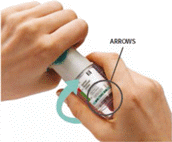
OPEN
- OPEN the cap until it snaps fully open.
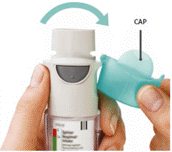
PRESS
- Breathe out slowly and fully.
- Close your lips around the mouthpiece without covering the air vents.
- While taking a slow, deep breath through your mouth, PRESS the dose-release button and continue to breathe in.
- Hold your breath for 10 seconds or for as long as comfortable.
- Repeat Turn, Open, Press for a total of 2 puffs.
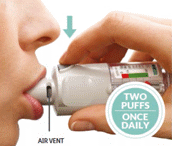
Answers to Common Questions
It is difficult to insert the cartridge deep enough
Did you accidentally turn the clear base before inserting the cartridge? Open the cap, press the dose-release button, then insert the cartridge.
Did you insert the cartridge with the wide end first? Insert the cartridge with the narrow end first.
Did you place the inhaler on a firm surface and push down firmly until the cartridge snaps into place? The cartridge should be pushed firmly against a firm surface to ensure that it has gone all the way in. The cartridge will not be flush with the inhaler, you will see the silver ring of the lower end of the cartridge.
I cannot press the dose-release button
Did you turn the clear base? If not, turn the clear base in a continuous movement until it clicks (half a turn).
Is the dose indicator on the Spiriva Respimat pointing to zero? The Spiriva Respimat inhaler is locked after 60 puffs (30 medicinal doses). Prepare and use your new Spiriva Respimat inhaler.
I cannot turn the clear base
Did you turn the clear base already?
If the clear base has already been turned, follow steps “OPEN” and “PRESS” under “Daily use” to get your medicine.
Is the dose indicator on the Spiriva Respimat pointing to zero? The Spiriva Respimat inhaler is locked after 60 puffs (30 medicinal doses). Prepare and use your new Spiriva Respimat inhaler.
The dose indicator on the Spiriva Respimat reaches zero too soon
Did you use Spiriva Respimat as indicated (two puffs/once daily)? Spiriva Respimat will last 30 days if used at two puffs once daily.
Did you turn the clear base before you inserted the cartridge? The dose indicator counts each turn of the clear base regardless whether a cartridge has been inserted or not.
Did you spray in the air often to check whether the Spiriva Respimat is working? Once you have prepared Spiriva Respimat, no test-spraying is required if used daily.
Did you insert the cartridge into a used Spiriva Respimat inhaler? Always insert a new cartridge into a NEW Spiriva Respimat inhaler.
My Spiriva Respimat sprays automatically
Was the cap open when you turned the clear base? Close the cap, then turn the clear base.
Did you press the dose-release button when turning the clear base? Close the cap, so the dose-release button is covered, then turn the clear base.
Did you stop when turning the clear base before it clicked? Turn the clear base in a continuous movement until it clicks (half a turn).
My Spiriva Respimat doesn’t spray
Did you insert a cartridge? If not, insert a cartridge.
Did you repeat Turn, Open, Press less than three times after inserting the cartridge? Repeat Turn, Open, Press three times after inserting the cartridge as shown in the steps 4 to 6 under “Prepare for first use”.
Is the dose indicator on the Spiriva Respimat pointing to 0? If the dose indicator points to 0, you have used up all your medication and the inhaler is locked.
Once your Spiriva Respimat is assembled, do not remove the clear base or the cartridge. Always insert a new cartridge into a NEW Spiriva Respimat inhaler.
Supplier
Spiriva Respimat inhaler is supplied in Australia by:
Boehringer Ingelheim Pty Limited
ABN 52 000 452 308
Sydney, Australia
www.boehringer-ingelheim.com.au
Manufacturer
Spiriva Respimat inhaler is manufactured by:
Boehringer Ingelheim Pharma GmbH & Co. KG
Binger Strasse 173
D-55216 Ingelheim am Rhein
Germany

Published by MIMS December 2020



 At week 24, Spiriva Respimat significantly improved morning and evening peak expiratory flow (PEF; mean improvement in the morning 23 L/min; 95% CI: 16 to 29 L/min, p < 0.0001; evening 26 L/min; 95% CI: 20 to 33 L/min, p < 0.0001).
At week 24, Spiriva Respimat significantly improved morning and evening peak expiratory flow (PEF; mean improvement in the morning 23 L/min; 95% CI: 16 to 29 L/min, p < 0.0001; evening 26 L/min; 95% CI: 20 to 33 L/min, p < 0.0001). Spiriva Respimat significantly reduced the risk of severe asthma exacerbations (see Table 3 and Figure 3).
Spiriva Respimat significantly reduced the risk of severe asthma exacerbations (see Table 3 and Figure 3).
 The Asthma Control Questionnaire (ACQ) responder rates, defined as percentage of patients improving by at least 0.5 points, were significantly higher with Spiriva Respimat (53.9% versus 46.9%; p = 0.0427).
The Asthma Control Questionnaire (ACQ) responder rates, defined as percentage of patients improving by at least 0.5 points, were significantly higher with Spiriva Respimat (53.9% versus 46.9%; p = 0.0427). In the 12 week GraziaTinA-asthma study in patients who were symptomatic on maintenance treatment with low dose ICS, Spiriva Respimat showed significant improvements in lung function over placebo when used as add-on to background treatment. At 12 weeks, the mean improvements in peak and trough FEV1 were 0.128 litres (95% CI: 0.057 to 0.199 litres, p < 0.0005) and 0.122 litres (95% CI: 0.049 to 0.194 litres, p < 0.0010), respectively.
In the 12 week GraziaTinA-asthma study in patients who were symptomatic on maintenance treatment with low dose ICS, Spiriva Respimat showed significant improvements in lung function over placebo when used as add-on to background treatment. At 12 weeks, the mean improvements in peak and trough FEV1 were 0.128 litres (95% CI: 0.057 to 0.199 litres, p < 0.0005) and 0.122 litres (95% CI: 0.049 to 0.194 litres, p < 0.0010), respectively. In the 12-week PensieTinA-asthma study in patients with severe asthma who were symptomatic on maintenance treatment of at least medium dose ICS in combination with 1 or more controller medication (e.g. LABA), Spiriva Respimat showed improvements in lung function over placebo when used as add-on to background treatment, however, the differences in peak and trough FEV1 were not statistically significant.
In the 12-week PensieTinA-asthma study in patients with severe asthma who were symptomatic on maintenance treatment of at least medium dose ICS in combination with 1 or more controller medication (e.g. LABA), Spiriva Respimat showed improvements in lung function over placebo when used as add-on to background treatment, however, the differences in peak and trough FEV1 were not statistically significant. In the 12-week VivaTinA-asthma study in patients with severe asthma who were symptomatic on maintenance treatment of at least medium dose ICS in combination with 1 or more controller medication (e.g. LABA), Spiriva Respimat showed significant improvements in lung function over placebo when used as add-on to background treatment.
In the 12-week VivaTinA-asthma study in patients with severe asthma who were symptomatic on maintenance treatment of at least medium dose ICS in combination with 1 or more controller medication (e.g. LABA), Spiriva Respimat showed significant improvements in lung function over placebo when used as add-on to background treatment.
